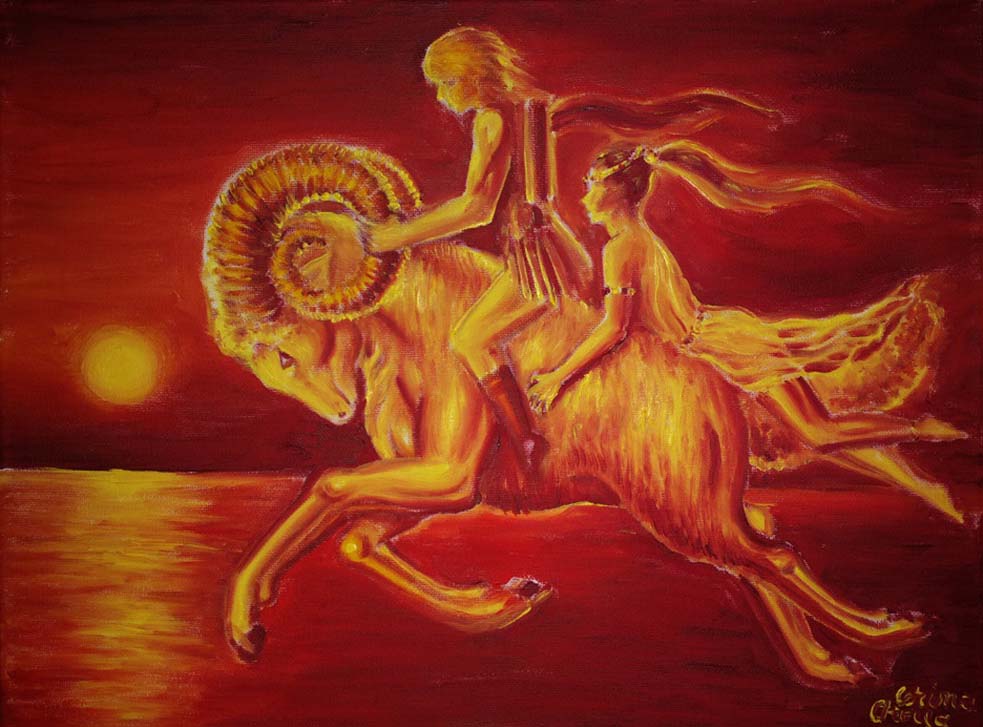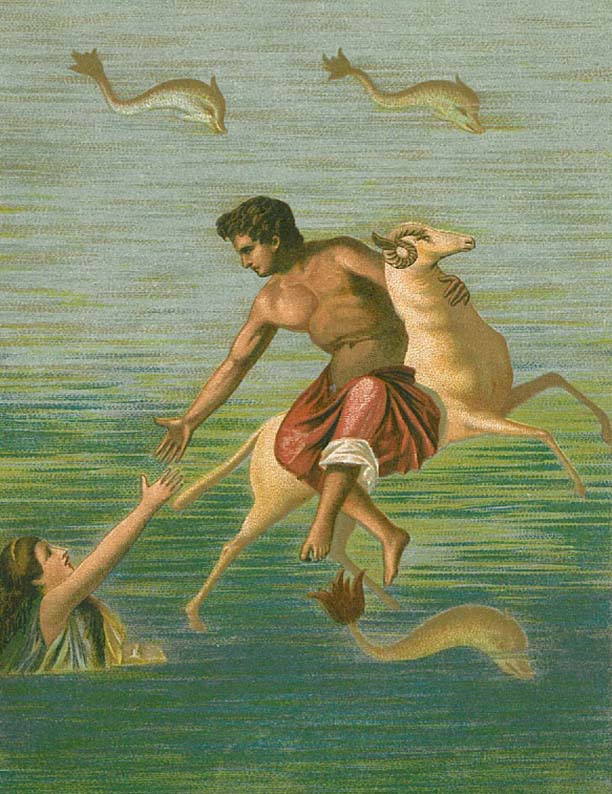
Helle

Helle (Ancient Greek: Ἕλλη), or Ellie, sometimes also called Athamantis (Ἀθαμαντίς), was a mortal princess and was a character in Greek mythology who figured prominently in the story of Jason and the Argonauts.
Helle was born in Boeotia, for Helle was the daughter of King Athamas and his first wife, the cloud nymph, Nephele. Thus, Helle was sister to a brother named Phrixus.
Athamas and Nephele did not stay wed for long and Helle, and Phrixus, would find that they had a stepmother, for Athamas now married Ino, a daughter of Cadmus and Harmonia.
Ino had no love for her stepchildren though, and having born Athamas two sons, Learchus and Melicertes, Ino sought to do away with Helle and her brother.
Ino hatched a devious plot to get rid of the twins, roasting all the town's crop seeds so they would not grow. The local farmers, frightened of famine, asked a nearby oracle for assistance. Ino bribed the men sent to the oracle to lie and tell the others that the oracle required the sacrifice of Phrixus.
Before he was killed though, Phrixus and Helle were rescued by a flying golden ram (aka, Crius Chrysomallus, the golden ram offspring of Poseidon) sent by Nephele, their natural mother.
The destination for Helle and Phrixus was Colchis, but it was a long flight from Boeotia, and Helle was not as strong as Phrixus, and soon the daughter of Athamas was having difficulty hanging on. At a point between Sigeium and Chersonesus, Helle finally lost her grip upon the fleece of the Golden Ram and plunged into the sea; a fall which is normally said to have killed Helle.
The place where Helle fell to her death would be known as the Hellespont, and was the name associated with the narrow strait of water between the Sea of Marmara and the Aegean. Even today, the name Hellespont is still used by some, but that strait of water is better known as the Dardanelles, although even this name has its roots in Greek mythology, for it comes from Dardanus, the name of a city and king of the Troad.
Nevertheless, although some sources suggest that Helle died after the fall yet, other sources propose that Helle was rescued by Poseidon, was turned into a sea-goddess and even lay with Poseidon, who bore the Olympian sea god two sons, the giants Almops and Paeon.

Sources
Hesiod, Catalogues of Women Fragments - Greek Epic C8th - 7th B.C.
Apollodorus, The Library - Greek Mythography C2nd A.D.
Apollonius Rhodius, The Argonautica - Greek Epic C3rd B.C.
Diodorus Siculus, The Library of History - Greek History C1st B.C.
Pausanias, Description of Greece - Greek Travelogue C2nd A.D.
Philostratus the Elder, Imagines - Greek Rhetoric C3rd A.D.
Tryphiodorus, The Taking of Ilias - Greek Epic C5th A.D.
Nonnus, Dionysiaca - Greek Epic C5th A.D.
Hyginus, Fabulae - Latin Mythography C2nd A.D.
Hyginus, Astronomica - Latin Mythography C2nd A.D.
Ovid, Metamorphoses - Latin Epic C1st B.C. - C1st A.D.
Ovid, Fasti - Latin Poetry C1st B.C. - C1st A.D.
Ovid, Heroides - Latin Poetry C1st B.C. - C1st A.D.
Propertius, Elegies - Latin Elegy C1st B.C.
Seneca, Troades - Latin Tragedy C1st A.D.
Valerius Flaccus, The Argonautica - Latin Epic C1st A.D.
Statius, Achilleid - Latin Epic C1st A.D.
Our Mobile Application
Check out Our Mobile Application "Ancient Greece Reloaded"


